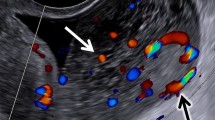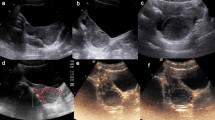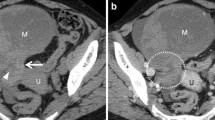Abstract
Purpose
To look for the presence of “perifollicular rim sign” on non-contrast CT in surgically proven cases of ovarian or adnexal torsion.
Methods
A retrospective analysis of abdominopelvic non-contrast CT examinations in surgically proven cases of ovarian or adnexal torsion was conducted seeking the presence of “perifollicular rim sign” in torsed ovaries. “Perifollicular rim sign” was defined as a complete ring of perifollicular hyperdensity around ovarian follicles with an attenuation value of > 50 HU and thickness > 1–2 mm. A positive sign was equated to the presence of perifollicular hemorrhage. Pre-operative non-contrast CT was available in 7 out of the 39 ovarian or adnexal torsions included in our study.
Results
“Perifollicular rim sign” was present in 5 out of the 7 ovarian torsions on pre-operative non-contrast CT. MRI correlation was available in one patient. Ovarian enlargement (>4 cm) was present in all 7 cases.
Conclusion
In an appropriate clinical setting, presence of “perifollicular rim sign” in an enlarged ovary on non-contrast CT examination can be considered a useful additional sign for ovarian torsion.





Similar content being viewed by others
References
Houry D, Abbott JT (2001) Ovarian torsion: a fifteen-year review. Ann Emerg Med 38:156–159. https://doi.org/10.1067/mem.2001.114303
Lourenco AP, Swenson D, Tubbs RJ, Lazarus E (2014) Ovarian and tubal torsion: imaging findings on US, CT, and MRI. Emerg Radiol 21:179–187. https://doi.org/10.1007/s10140-013-1163-3
Bhosale PR, Javitt MC, Atri M, Harris RD, Kang SK, Meyer BJ, Pandharipande PV, Reinhold C, Salazar GM, Shipp TD, Simpson L, Sussman BL, Uyeda J, Wall DJ, Zelop CM, Glanc P (2016) ACR appropriateness criteria® acute pelvic pain in the reproductive age group. Ultrasound Q 32:108–115. https://doi.org/10.1097/RUQ.0000000000000200
Rha SE, Byun JY, Jung SE, Jung JI, Choi BG, Kim BS, Kim H, Lee JM (2002) CT and MR imaging features of adnexal torsion. Radiographics 22:283–294. https://doi.org/10.1148/radiographics.22.2.g02mr02283
Hiller N, Appelbaum L, Simanovsky N, Lev-Sagi A, Aharoni D, Sella T (2007) CT features of adnexal torsion. AJR Am J Roentgenol 189:124–129. https://doi.org/10.2214/AJR.06.0073
Chiou S-Y, Lev-Toaff AS, Masuda E, Feld RI, Bergin D (2007) Adnexal torsion: new clinical and imaging observations by sonography, computed tomography, and magnetic resonance imaging. J Ultrasound Med 26:1289–1301. https://doi.org/10.7863/jum.2007.26.10.1289
Chang HC, Bhatt S, Dogra VS (2008) Pearls and pitfalls in diagnosis of ovarian torsion. Radiographics 28:1355–1368. https://doi.org/10.1148/rg.285075130
Duigenan S, Oliva E, Lee SI (2012) Ovarian torsion: diagnostic features on CT and MRI with pathologic correlation. AJR Am J Roentgenol 198:W122–W131. https://doi.org/10.2214/AJR.10.7293
Sibal M (2012) Follicular ring sign: a simple sonographic sign for early diagnosis of ovarian torsion. J Ultrasound Med 31:1803–1809. https://doi.org/10.7863/jum.2012.31.11.1803
Petkovska I, Duke E, Martin DR, Irani Z, Geffre CP, Cragun JM, Costello JR, Arif-Tiwari H, Czeyda-Pommersheim F, Udayasankar U, Kalb B (2016) MRI of ovarian torsion: correlation of imaging features with the presence of perifollicular hemorrhage and ovarian viability. Eur J Radiol 85:2064–2071. https://doi.org/10.1016/j.ejrad.2016.09.020
Rodgers RJ, Irving-Rodgers HF (2010) Formation of the ovarian follicular antrum and follicular fluid. Biol Reprod 82:1021–1029. https://doi.org/10.1095/biolreprod.109.082941
Moro F, Bolomini G, Sibal M, Vijayaraghavan SB, Venkatesh P, Nardelli F, Pasciuto T, Mascilini F, Pozzati F, Leone FPG, Josefsson H, Epstein E, Guerriero S, Scambia G, Valentin L, Testa AC (2020) Imaging in gynecological disease (20): clinical and ultrasound characteristics of adnexal torsion. Ultrasound Obstet Gynecol 56:934–943. https://doi.org/10.1002/uog.21981
Parizel PM, Makkat S, Van Miert E, Van Goethem JW, van den Hauwe L, De Schepper AM (2001) Intracranial hemorrhage: principles of CT and MRI interpretation. Eur Radiol 11:1770–1783. https://doi.org/10.1007/s003300000800
Author information
Authors and Affiliations
Contributions
All authors made substantial contributions towards conception, analysis and interpretation of data, drafting the manuscript, and critical revision. The authors agree to be accountable for all aspects of the work.
Corresponding author
Ethics declarations
Conflict of interest
The authors declare that they have no conflict of interest.
Additional information
Publisher’s note
Springer Nature remains neutral with regard to jurisdictional claims in published maps and institutional affiliations.
Rights and permissions
About this article
Cite this article
Batchala, P.P., Nepal, P., Wankhar, B. et al. “Perifollicular rim sign” in an enlarged ovary—an additional non-contrast CT finding in ovarian torsion. Emerg Radiol 28, 621–626 (2021). https://doi.org/10.1007/s10140-021-01904-7
Received:
Accepted:
Published:
Issue Date:
DOI: https://doi.org/10.1007/s10140-021-01904-7




